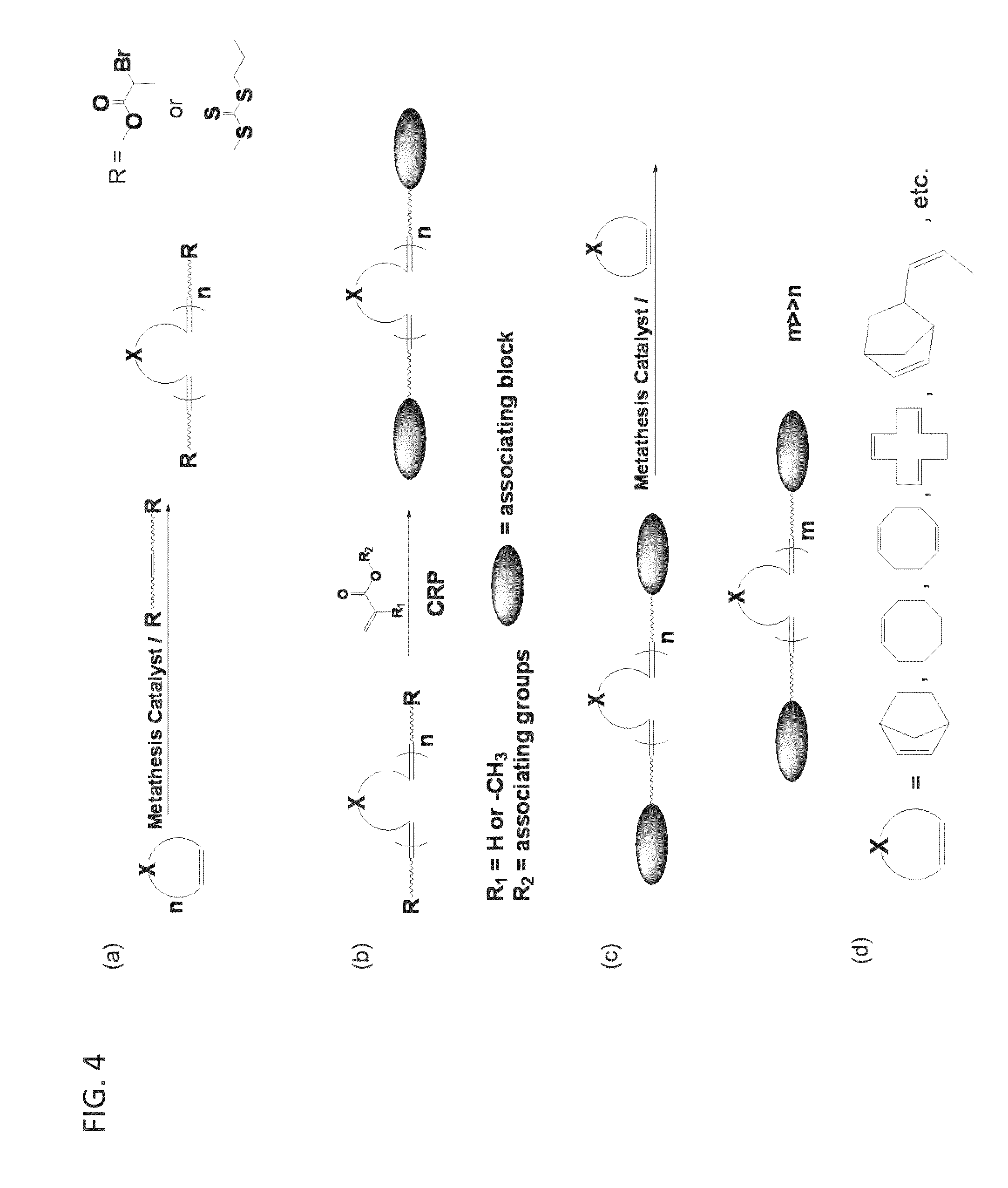Associative polymers for mist-control
a technology of associative polymers and mist control, which is applied in the direction of fuel additives, liquid carbonaceous fuels, fuels, etc., can solve the problems of not having implemented fuel fire hazard reduction technology, the destructive power of a fully-fueled aircraft comes from fuel, and the threat to high-rise buildings, sports arenas, nuclear power facilities,
- Summary
- Abstract
- Description
- Claims
- Application Information
AI Technical Summary
Benefits of technology
Problems solved by technology
Method used
Image
Examples
example 1
Development of a Theoretical Model
[0099]Herein, a theoretical underpinning is provided that describes how molecules can be designed that overcome chain collapse by clustering associating groups at the ends of polymer chains. In particular, a model is constructed that can predict for long linear chains endcapped with strongly associating groups, the equilibrium partitioning of the polymer into supramolecular chains and supramolecular loops of all sizes.
[0100]In the model, it is assumed that the A and B endgroups associate with each other pair-wise with interaction energy εkT, but that neither the A nor the B endgroups self-associate. Under these assumptions, to model the equilibrium aggregation of telechelic polymers A----A and B----B into supramolecular cyclic and linear chains of any length (see, scheme provided in FIG. 6), the simpler case of association of telechelic polymers A1----A2 and B1----B2, is first considered. In doing so, it can be assumed that the end-groups A1 and A2,...
example 2
Computational Example
[0151]Now that the theoretical model has been explained, it can be used to test whether linear chains possessing strongly associating endgroups can be useful as mist-control additives to aviation fuel. In this section, computational results are given for a case of practical significance that can be tested experimentally using anionically polymerized telechelics: monodisperse polyisoprene (PI) chains with strongly associating endgroups, in dilute solutions in Jet-A solvent.
[0152]In addition, it is shown computationally and / or experimentally using modified polybutadiene (PB) chains (shown in FIGS. 1b and 1c) that in dilute solution, i) self-associating polymer chains (e.g. molecules shown in FIG. 1b) collapse onto themselves, becoming less effective mist-control agents than linear non-associating chains of the same molecular weight, and ii) interpolymer complexes formed by blending e.g. proton-donating chains and proton accepting chains (shown in FIG. 1c, right) o...
example 3
Rheological Study
[0205]The solution rheology of a pair of proton-donating / accepting end-to-end associating polymers (100KA10 and 100KN50) in a widely used aviation fuel Jet-A was studied at 40° C. under steady-state shear field. 100KA10 denotes a tri-block copolymer poly(acrylic acid)-block-poly(cyclooctene)-block-poly(acrylic acid) (average molecular weight=105 g mole−1), in which the total number of acrylic acid units is 10; likewise, 100KN50 denotes a tri-block copolymer poly(2-(dimethylamino)ethyl methacrylate)-block-poly(cyclooctene)-block-poly(2-(dimethylamino)ethyl methacrylate) (average molecular weight=105 g mole−1), in which the total number of 2-(dimethylamino)ethyl methacrylate units is 50. Both polymers were prepared by the combination of ring-open metathesis polymerization (ROMP) of cyclooctene and atom-transfer radical polymerization of acrylate monomers. Solutions of 100KA10 and 100KN50 in Jet-A were prepared respectively at a weight concentration of 1.4 wt %, which ...
PUM
| Property | Measurement | Unit |
|---|---|---|
| weight average molar mass | aaaaa | aaaaa |
| temperatures | aaaaa | aaaaa |
| temperature | aaaaa | aaaaa |
Abstract
Description
Claims
Application Information
 Login to View More
Login to View More - R&D
- Intellectual Property
- Life Sciences
- Materials
- Tech Scout
- Unparalleled Data Quality
- Higher Quality Content
- 60% Fewer Hallucinations
Browse by: Latest US Patents, China's latest patents, Technical Efficacy Thesaurus, Application Domain, Technology Topic, Popular Technical Reports.
© 2025 PatSnap. All rights reserved.Legal|Privacy policy|Modern Slavery Act Transparency Statement|Sitemap|About US| Contact US: help@patsnap.com



